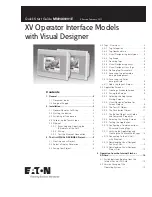
8
Quick Start Guide
MN0480001E
Effective February 2011
XV Operator Interface Models
with Visual Designer
eaton Corporation
www.eaton.com
checking this option can cause frequent access to your XV’s flash
ote:
N
device, based on your application
Dead Band:
The Dead Band field is used to filter alarms. It is a value
of variance around an Alarm value that the tag can vary before trig-
gering an alarm. For example, if an Alarm Hi Limit is set to 90 and
the Dead Band value set to 5, then an Alarm will be generated when
the tag value is
≥
95, and the Alarm will return to a Normal state
(normalized) when the tag value is
≤
90.
Smoothing:
A checkbox that, when checked, enables the Visual
Designer database manager to reduce the rate of change for a tag
by averaging the current value with the previous value. The averaged
value is then stored in the tag value.
Along with the tag
Properties that are
accessible in the
Datasheet View,
additional tag
Properties can be
accessed by the Tag
Properties Tool. This
tool can be used by
opening the Datasheet View, selecting (left mouse click) the tag of
interest and then activating the Tags Property tool (left mouse click
on the icon) in the Ribbon’s Home tab, Tags section.
The Tag Property Tool has three (3) dialog boxes, selectable by tabs
on the top of the dialog box. The first tab allows you to specify the
same Tag Properties that are accessible from the Datasheet View
(with all columns enabled). The second tab allows you to set tag
parameters that are also set by an Alarm Worksheet (Task Tab of the
Visual Designer workspace), although an Alarm Worksheet provides
additional configuration options. The last tab allows setting of some
of the parameters that are specified in a Trend Worksheet (Tasks Tab
in the Visual Designer workspace). It should be noted that if any of
these Properties are changed in the Alarm or Trend Worksheet, those
values will be written into the fields shown here.
3.4.10 Accessing tag fields during runtime
Accessing Tag Fields (Parameters) during runtime is straightforward,
and is done through the following syntax:
Tag->FieldName
•
where Tag is the name of the tag (for all tag types)
•
-> is the minus sign and a right arrow
FieldName is the name of the Tag Field (see table below).
Here are a couple examples:
v1->Max will return the maximum value allowed for the tag.
•
(normally max & min are set to 0 to allow all value ranges)
v2->Quality returns the tag quality value (192 = Good, 0 = Bad)
•
If the tag is an array, depending on the Field used, you will want to
either use just the array name or use the array name with the index.
For example, if we have an array called Switches with a Size of 5:
Switches->Size will return a value of 5
•
Switches[Count]->Index will return the value of the tag Count
•
used as the index to the array Switches
If the tag is an Array of Class tags, you can refer to the Array name,
Array name with Index, or the Class Members. Using the previously
defined Array of Class tags (tanks), for example:
tank->Size returns a value of 5
•
tank[1]->Index returns a value of 1
•
tank[2].Level->MemberName returns the string “Level”
•
tank[3].Level->TimeStamp returns a time & date when the level
•
last changed
3.4.11 Add a tag to your Project
In your project go to the Database tab in the Workspace box, expand
the Application Tags by clicking on the plus sign then double-click on
“Datasheet View” and add the tag hmiCounter as shown below then
right-click on the Application Tags tab to the right of the Workspace
box and select “Save”, then right click again and select “Close”:
3.5 Application Screens
3.5.1 Creating a Standard Screen
A Standard Screen is the simplest and most basic screen type. To
create a Standard Application screen, select the Graphics Workspace
Tab. Next, right click on the Screens folder to select the option to
insert a new Screen. Left click on the Insert popup to insert the new
Screen.
Screens
Graphics
Workspace
Tab
Tag Property Icon
















